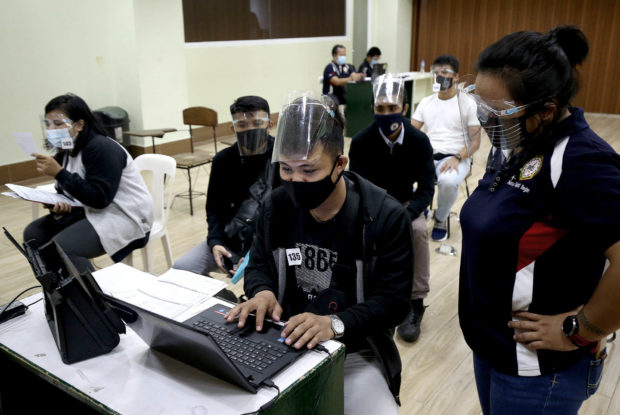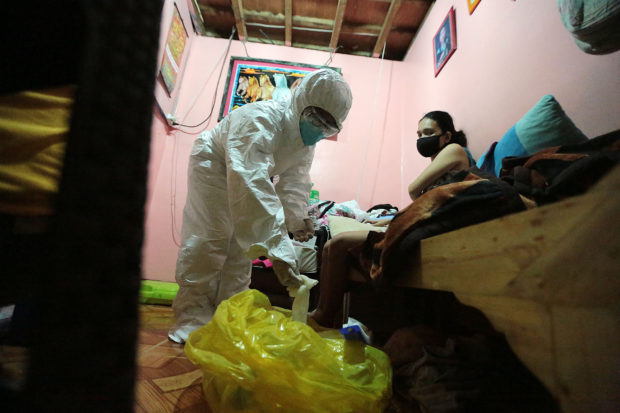
Applicants for the job of the contract tracer undergo interview at the Universidad de Manila. RICHARD REYES
(First of two parts)
MANILA, Philippines — On Sept. 30, Ela Elesterio of Pasay City was told that she had tested positive for COVID-19. Three days later, a team from the local government was at her house for contact tracing.
No such speed marked the experience of “Angelica” and her family back in July. She said her mother had been found positive for the coronavirus in a swab test that was a requirement for admission at the National Kidney and Transplant Institute in Quezon City. But it was only after 11 days that a team from their local government visited their house to swab her mother’s close contacts.
Angelica’s experience was not unique, according to Baguio City Mayor and “contact tracing czar” Benjamin Magalong. To illustrate his point, he cited a report stating that no contact tracing was administered to two families with 15 members in a Metro Manila city who had been in close quarters with a COVID-19 patient.
All these incidents validate the observation of the World Health Organization (WHO) representative in the Philippines, Dr. Rabindra Abeyasinghe, that the country’s contact-tracing efforts are “a little weak.”
The WHO specifies one contact tracer per every 800 persons. On that ratio, the Philippines needs at least 135,000 contact tracers for its population of 110 million.
Magalong said the shortage of contact tracers had been a problem for many local government units (LGUs) since the Department of Health (DOH) passed the responsibility of contact tracing to them in April.
“They are just overwhelmed by the number of cases. Our contact tracers are already tired,” he told the Inquirer in a phone interview.
In Metro Manila, “the national contact tracing efficiency ratio” is only five or six close contacts of COVID-19 patients, Magalong said. “We have designed 1:37 as a benchmark figure for urban areas and 1:30 for rural areas.”
The number of unaccounted contacts is a factor in the rise in COVID-19 cases in the country, the mayor said. “Can you imagine if you only trace five contacts for every positive patient every day? And if you have three cases a day, you only identified 15 close contacts?” he said.
Magalong continued with his computations: Applying this to the 1:25 benchmark for patient-close contacts ratio, 75 contacts need to be traced. “Now, you minus 15 from 75, you are looking at 60 unidentified or unaccounted close contacts.”
Assuming a 10 percent positive rate among close contacts, “that’s six people potentially infected, unidentified, unaccounted, and roaming the streets potentially infecting other people.”
“If that trend continues for 10 days, then you are looking at 60 people, unidentified, unaccounted, potentially infecting other people. That is how important contact tracing is.”
In August, more than five months since the DOH confirmed the first local transmission of COVID-19 in the country, the government had only 91,000 contact tracers (or 44,000 short of the recommended 135,000), said Interior Undersecretary Bernardo Florece Jr., who is in charge of the contact-tracing efforts of the Department of the Interior and Local Government (DILG).
Under the Bayanihan to Recover As One Act (or Bayanihan 2), the DILG was given a P5-billion budget to hire and train 50,000 contact tracers.
Interior Secretary Eduardo Año said 26,000 of the target number had been hired and deployed to various provinces as of Oct. 10.

A contact tracing team from the City Epidemiology and Surveillance Unit (CESU) of the Quezon City government conducts house to house tracing of possible CoVid19 patients in Brgy. Baesa on Wednesday, July 15, 2020.The team is accompanied by a plainclothes police officer. INQUIRER PHOTO / GRIG C. MONTEGRANDE
Magalong said the additional 50,000 contact tracers would “enhance the performance of LGUs” in containing the spread of the coronavirus.
“The 50,000 will be a … huge game changer,” he said. “But they should be properly trained, properly capacitated.”
Among the LGUs, Valenzuela City has “very good contact tracing,” Magalong said.
Since the start of the lockdown on March 12, Valenzuela’s Epidemiology and Surveillance Unit has grown from 10 members to a 100-strong team.
In August, the city opened a mega contact tracing center operating 24/7 and staffed by at least 100 personnel, including data encoders, schedulers, contact tracers and surveillance officers.
“Basically, it’s a call center where people would call in,” said Valenzuela Mayor Rex Gatchalian. “Then the agents will walk you through it, they will do triage … Then if they determine that you have it, or you have high-risk exposure, and if the symptoms match, they will schedule you for the swab testing.”
Gatchalian said all testing, including of close contacts of COVID-19 patients, were being administered for free, courtesy of the local government.
When a call is made, “we can swab you in as fast as 48 hours,” Gatchalian told the Inquirer.
This is how they do it, according to the mayor: “We do home swabbing. We … don’t make people come to a center where they are swabbed because we firmly believe that people with high-risk exposure or any type of exposure are suspects that should stay at home.
“So we send a team that will swab them at home. We put the house on lockdown… and when in lockdown, they will be guarded.
“The police will come in, the barangay will come in. Nobody is allowed to leave the house until the results are back.
“Once the results come in, the call center agents will call and tell [them] the results.
“Then we also leave a box of food that’s good for at least a week and a half, so that [they] would have food to eat just in case the results [are] delayed.”
But with the opening of the new molecular laboratory in the city, Gatchalian said, “we can do it as fast as 24 hours because our laboratory will be fully automated.”
If the swab results turn out positive, “we deploy an extraction team that will pull you out and put you in an isolation unit because we [have not allowed] home quarantine in Valenzuela ever since Day 1,” the mayor said.
Valenzuela has 12 isolation units with close to 1,100 beds.
“At any given time, nobody is allowed to do home quarantine in Valenzuela, no matter who you are,” Gatchalian said.
He said further contact tracing would be conducted by phone. Once this is done, the data gathered will be passed to the surveillance officers “to do validation on the ground.”
Gatchalian described it as “a twofold process: First, it’s self-assessment. You tell me who your contacts are, then we revalidate it using our surveillance officers.”
Valenzuela has 330 surveillance officers, including barangay health workers, doctors and nurses, on the ground and at least 160 call center agents at the mega contact tracing center. In October, another 226 contact tracers were deployed as part of the first batch hired by the DILG for the city.
Año said the contact tracers hired by the DILG would earn a minimum P18,784 a month in a service contract. But even before then, the city-hired contact tracers were earning between P12,000 and P15,000 a month, Gatchalian said.
Part 2: ‘It’s a medical emergency, so our response should be medical’